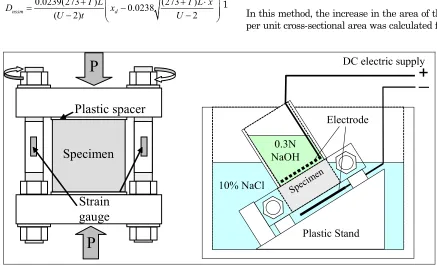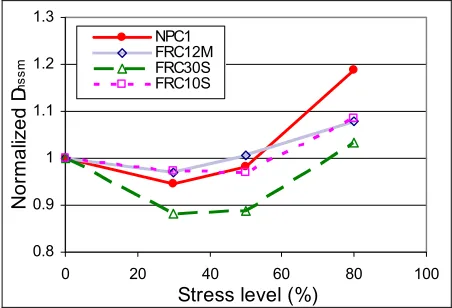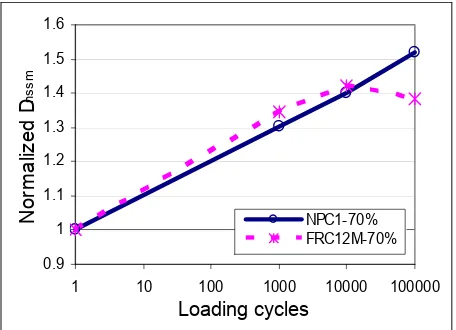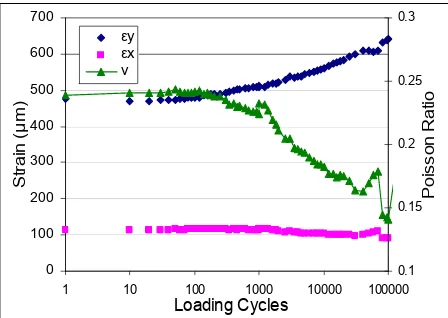Civil Engineering Dimension
Chloride Penetration into Fiber Reinforced Concrete under
Static and Cyclic Compressive Loading
Antoni1
Abstract: The effect of loading on the chloride penetration into plain concrete (PC) and fiber reinforced concrete (FRC) was studied experimentally by using modified NT Build 492 – Non-steady state chloride migration test that include the application of loading on the specimen during the test. Three types of polypropylene fibers with different lengths and shapes were used. The concretes were tested for chloride penetration at different stress ratios under static and cyclic loading. The results of the static loading showed that there was a slight reduction in the chloride penetration under low level of compressive stress while an increase in the chloride penetration was found at higher stress level. There are significance difference in chloride penetration behavior of the plain concrete, long fiber FRC and short fiber FRC. Chloride penetration increased even more at cyclic loading conditions showing difference behavior of FRC and PC at difference number of cycle and load level.
Keywords: chloride ions, migration, diffusion, static and cyclic loading, polypropylene fiber.
Introduction
Concrete structures in marine environment are subjected to chloride penetration that could initiate corrosion of the reinforcement. The corrosion can significantly degrade the structural performance and their lifetime. In order to have a better prediction on the service life of the concrete structures under marine environment, the effect of loading on the chloride penetration into concrete needs to be studied. Loading on the concrete was investigated because it represents the actual condition of concrete structures at service time.
During the service period, concrete structures are subjected to its self weight, service load such as traffic, wind, and earthquake load, and also accidental loading such as impact load. These loading conditions could change the chloride penetration rate into the concrete structure and consequently change the service life time of the structure. Some studies have shown that concrete under loading conditions, especially under tensile loading, reduce the resistance of concrete against chloride penetration [ 1,2,3].
1, Department of Civil Engineering, Petra Christian University,
Surabaya, Indonesia. E-mail: [email protected]
Note: Discussion is expected before November, 1st 2008, and will be published in the “Civil Engineering Dimension” volume 11, number 1, March 2009.
Received 25 May 2008; revised 26 July 2008; accepted 29 July 2008.
Several studies dealing with chloride penetration of concrete by subjecting axial load to concrete to give residual strain and then measure diffusion coefficient of chloride penetration into concrete under stress-free condition [4, 5]. This testing condition could not represent chloride penetration in real concrete structure where load is always present, therefore alternate test method which incorporate loading at testing was used in this research.
Inclusion of fibers into concrete has some benefits that include increased energy absorption, fracture toughness [6]. The combination of polypropylene short fiber with steel reinforcement is expected to improve the behavior of concrete material by increasing its ductility and energy absorption capacity. Moreover, fiber reinforced concrete could perform better to resist chloride penetration under loading as the fibers have a crack bridging effect that could reduce the appearance of microcracks. The effectiveness of the fiber in resisting chloride penetration was investigated in this research by conducting the testing under static and cyclic loading to simulate the actual loading conditions.
Methodology
Non-steady state migration
The effect of loading on the chloride penetration was studied by conducting Modified NT Build 492 test that introduces loading at the time of testing, as shown in Figure 1. The concrete specimen was loaded by using an external frame and then a vacuum pre-treatment procedure was conducted as described in the standard. The non-steady state migration test was then conducted while the specimen was still under load. After the migration test which takes 24 hours, the specimen was released from loading and split at the center of the specimen. The chloride penetration depth was measured by the change of color after spraying with silver nitrate solution.
The chloride non-steady state migration coefficient can then be calculated from Equation (1) given in NT Build 492 [7]:
0.0239(273 ) (273 )
0.0238
( 2) 2
nssm d
T L T L x
D x
U t U
⎛ ⎞
+ + ⋅
= − ⎜⎜ − − ⎟⎟
⎝ ⎠
1
where
Dnssm = diffusion coefficient, × 10–12 m2/s;
T = temperature of solution, °C; L = specimen thickness, mm; U = applied potential, V; t = test duration, h.; and
xd = average penetration depth, mm.
Microcracks evaluation
The microcracks evaluation conducted in this study was based on the indirect microcracks area measurement proposed by Loo [8]. The method to measure the crack area was done with the assumption that the change of cross-sectional area of a prismatic concrete specimen under uniaxial compression can be resolved into two parts, i.e. the elastic change of cross sectional area due to Poisson’s ratio effects and the dilation due to microcracking.
In this method, the increase in the area of the crack per unit cross-sectional area was calculated from the
P
P
Specimen
Plastic spacer
Strain
gauge
10% NaCl
0.3N NaOH
Spec imen
+
_
Plastic Stand
DC electric supply
Electrode
Fig. 1. Migration test setup for chloride penetration under compressive loading. Loading was applied on the specimen using external stainless steel frame.
PP12M PP30S
PP10S
measured longitudinal and transversal strain using a simple formula which involves the elastic Poisson’s ratio determined a priori from the strain data. The increase of crack area per unit cross-sectional area or the specific crack area is given in Equation 2 [8]:
2(
)
Outline of test specimens
Three types of fiber were used to make fiber reinforced concrete in this study. Figure 2 shows mesh type 12 mm polypropylene fiber (PP12M), mono-filament type 10 mm polypropylene fiber (PP10S) and mono-filament type 30 mm stiffer polypropylene fiber (PP30S) used. Fiber diameters are 0.31 mm (equivalent), 0.23 mm and 1.0 mm for PP12M, PP10S and PP30S, respectively.
For all cases, the water to cement ratio (w/c), water content and sand by aggregate volume fraction were fixed at 0.5, 175 kg/m3, and 0.52 respectively. The maximum aggregate size used was 12 mm. Addition of superplasticizer and air entrainment agent were used to achieve target slump of 10 cm and air content of 5 to 7%. The mix-design of the concrete and its physical properties are shown in Table 1. The measured diffusion coefficient, Dnssm, also is given for
non-loading conditions.
The specimens were cured in water for 60 days. After water curing, the prismatic specimens were cut by water-cooled concrete cutter perpendicular to its axis into 50±2 mm thick specimens. All specimens were then placed in room condition for additional 30 days before performing the chloride migration test.
For static compressive loading, migration test was conducted on all of the concrete types. Loading variations performed were 30%, 50% and 80% stress level of the maximum compressive strength. 50% and 80% stress level used in order to fully
understand the behavior of the chloride penetration at higher loading condition and to investigate the effect of fiber inclusions in the concrete specimens.
For cyclic compressive loading, the test was con-ducted on NPC1 and FRC12M. Loading variations were conducted at 30%, 50% and 70% stress level for 1,000, 10,000 and 100,000 cycles. And then the chloride penetration test was conducted at 30% compressive stress level under static loading. Three replications were conducted for all condition.
The specimens were cured in water for 60 days. After water curing, the prismatic specimens were cut by water-cooled concrete cutter perpendicular to its axis into 50±2 mm thick specimens. All specimens were then placed in room condition for additional 30 days before performing the chloride migration test.
For static compressive loading, migration test was conducted on all of the concrete types. Loading variations performed were 30%, 50% and 80% stress level of the maximum compressive strength. 50% and 80% stress level used in order to fully understand the behavior of the chloride penetration at higher loading condition and to investigate the effect of fiber inclusions in the concrete specimens.
For cyclic compressive loading, the test was conducted on NPC1 and FRC12M. Loading variations were conducted at 30%, 50% and 70% stress level for 1,000, 10,000 and 100,000 cycles. And then the chloride penetration test was conducted at 30% compressive stress level under static loading. Three replications were conducted for all condition.
Results And Discussion
Effect of static compressive loading
Chloride penetration into the concrete specimen was measured at 0%, 30%, 50% and 80% of the maxi-mum compressive strength. The normalized diffusion coefficient of the migration test result of chloride penetration (Normalized Dnssm) into plain
concrete and three types of fiber reinforced concrete under compressive loading are presented in Figure 3.
Table 1. Mix proportion and physical properties of concrete.
0.8
Fig. 3. Normalized chloride penetrations under compres-sive loading.
All of the concrete showed a reduced chloride penetration rate for lower stress level. Up to 30% stress level, there is a reduction of chloride penetration compared to non-loading conditions. This condition could be attributed to the increase in the density of concrete due to loading before any microcracks could occur. Similar trend of reduced chloride penetration under lower compressive loading was also reported by other researchers [4, 9, 10]. Larger reduction of chloride penetration rate for FRC30S could be attributed to higher fiber volume fraction causing concrete to be compressed even more at loading.
At 50% stress level, there was practically no increase for the FRC10S and FRC30S while there was a slight increase for NPC1 and FRC12M compared to 30 % stress level, the increment could be due to the testing variation.
However, from 50% to 80% stress level, there was some increase in the chloride penetration for all types of concrete. The increase is highest for NPC1. FRC30S shows the similar increase of NPC1 at this loading range. However, due to the reduction of the chloride penetration at lower loading, the chloride penetration rate is still lower than plain concrete. The polypropylene fiber reinforced concrete showed a smaller increase of chloride penetration at loading of 80% stress level. The increase of chloride penetration was less than 10% for the polypropylene fiber reinforced concrete, and about 20% for the plain concrete compared to the 50% stress level. This result showed that short fiber reinforced concrete has better performance when subjected high compressive loading compared to plain concrete.
Figure 4 shows the specific cracks area of the concrete as measured by indirect microcrack evaluation. It is shown in the figure that there is a difference rate of the increase of crack area with the
increase of loading. FRC with shorter fiber (FRC12M and FRC10S) showed a reduced increase of the specific crack area compared to NPC1 and FRC30S. This result shows that the shorter fiber was quite effective to reduce the increase of crack area and thus reducing the increase of chloride penetration at the higher load ratio. NPC1 showed an increase of crack width at 40% stress level while FRC30S showed increase at 50% stress level. Longer fibers, in this case PP30S, have a lower influence of reducing the chloride penetration rate at higher loading condition. The reason could be due to the distribution of the fibers in the concrete matrix. Smaller fibers (PP10S and PP12M) are better distributed in the concrete matrix resulting in better crack bridging properties. Small microcracks could occur in the area between the longer fibers thus the crack bridging effect of longer fiber was lower. In agreement with Lim et al [5], there are correlation of increase of microcracks area with that of chloride penetration when concrete was under compressive loading. However, the change of chloride penetration should be measured when the concrete was under loading. When the result in the Figure 3 replotted with 30% stress level as the reference, as shown in Figure 5, the relationship of spesific crack area and chloride penetration rate was more visible. However there is some inconsistencey for the FRC30S. This behavior could be attributed to the number of crack generated by the fiber inclusion rather than crack areas. Further investigation is needed.
-25
Fig. 4. Increase of specific crack area with increase in the stress level.
Effect of cyclic compressive loading
specimen under cyclic loading compared to the non loading or static loading condition. However, with increase of cycles, the chloride penetration does not appear to be increasing.
0.9
Fig. 5. Normalized chloride penetrations under compres-sive loading at 30 stress level.
0.9
1 10 100 1000 10000 100000
Loading cycles
Fig. 6. Chloride penetration of 30% cyclic loading.
0.9
1 10 100 1000 10000 100000
Loading cycles
Fig. 7. Chloride penetration of 50% cyclic loading.
0.9
1 10 100 1000 10000 100000
Loading cycles
Fig. 8. Chloride penetration of 70% cyclic loading.
PP12M polypropylene fiber shows its performance when the concrete was loaded at 50% of maximum compressive strength (Fig. 6). It was shown that the inclusion of fiber was effective to prevent the increase of chloride penetration with the increase of loading cycles. The result shows that the bridging effect of the fiber was effective to prevent the increase of damage in the concrete when the concrete was loaded at 50% stress level.
When the concrete was subjected to cyclic loading of 70%, both NPC1 and FRC12M showed an increase of chloride penetration with the increase of loading cycles (Fig. 7). The concrete showed an increase of chloride penetration logarithmically with the increa-se of loading cycles.
The measurement of microcrack area was not done for cyclic loading because the change of modulus of elasticity of concrete with increase of cycles. Longitudinal (εy) and transversal strain (εx) was
measured with the increase of number of cycles instead. To accentuate the damage condition, inelastic poisson ratio (v) was use as the ratio of transversal strain (εx) and longitudinal (εy). Increase
of the longitudinal strain with the increase of the number of cycles was due to creep due to loading while the increase of transversal strain was an indication of the cumulative damage such as an increase of crack area.
Figures 8 and 9 show the change of strain with the increase of cyclic number for NPC1 and FRC12M at 50% cyclic loading. It was shown that there is an increase in the transversal strain (εx) at 5000 cycles
0
1 10 100 1000 10000 100000
Loading Cycles
Fig. 8. Strain change of 50% cyclic loading NPC1
0
1 10 100 1000 10000 100000
Loading Cycles
Fig. 9. Strain change of 50% cyclic loading FRC12M
Increase of transversal strain was observed also for the cyclic loading of 70% since lower cycles showing that the damage started earlier. When comparing the changes in the transversal strain and the changes in chloride penetration, there are close correlation between them. Increase of the transver-sal strain could be used as a parameter to see the changes in the chloride penetration.
Conclusions
1. Loading on concrete had a significant effect on the chloride penetration rate into concrete. Under low static compressive loading, there could be a reduction in the chloride penetration depending on the type of concrete. At higher static compres-sive loading, an increase in chloride penetration was found for all concrete.
2. Increase in the chloride penetration is more pronounce when the concrete is subjected to cyclic compressive loading. Small and insignificant damage in the concrete material could accu-mulate under cyclic loading and increasing the chloride penetrability.
3. Low level of cyclic loading does not show increasing chloride penetration with the increase of the number of cycles, however when comparing to static or non loading condition, there is still some increase.
4. Moderate stress level loading shows the different behavior of plain concrete and fiber reinforced concrete. Chloride penetration in NPC1 increased with increase in the number of cycles, but there was no increase in the chloride penetration with increase in the number of cycles for FRC12M. 5. At higher stress level, there was an increase in
the chloride penetration with the increase of number of cycles showing cumulative damage. NPC1 and FRC12M showed logarithmic increase in the chloride penetration with increase in the number of cycles.
6. The increase of the chloride penetration under static compressive loading was found to be related to the increase of specific microcracks area under compressive loading. With the increase of the specific crack area, the chloride penetration is increased in a similar manner. 7. Changes in the transversal strain in the concrete
could be an indication of the changes in chloride penetrability with the increase of cyclic loading. Increase in the transverse strain shows that there is an increase of damage in the concrete and would increase the chloride penetration into concrete.
References
1. Antoni, Horiguchi, T., and Saeki, N., Influence of Stress on Chloride Penetration into Fiber Rein-forced Concrete, Proc. of the Japan Concrete Institute, v.25, 2003, pp, 779-784.
2. Antoni, Horiguchi, T., and Saeki, N., Performance of Fiber Reinforced Concrete Against Chloride Penetration under Loading, Proc. of the Japan Concrete Institute, v. 26, 2004, pp, 921-926.
3. Antoni, Assessment of Chloride Penetration into Fiber Reinforced Concrete under Loading, Proc. of 1st International Conference on Modern Design, Construction and Maintenance of Struc-tures, 10-11 December 2007, Hanoi, Vietnam, Vol 2, pp, 45-50.
4. Saito, M. and Ishimori, H., Chloride Permeability of Concrete under Static and Repeated Loadings, Cement and Concrete Research, v. 25, 1995, pp, 803-808.
6. Lee, M.K. and Barr, B.I..G, An Overview of the Fatigue Behavior of Plain and Fiber Reinforced Concrete, Cement and Concrete Composite, v. 26, 2004, pp, 299-305.
7. Nordtest NT BUILD 492, Chloride Migration Coefficient from Non-steady State Migration Experiment, Nordtest, Finland, 1999.
8. Loo, Y.H, New Method for Microcracks Evalua-tion in Concrete under Compression, Materials and Structures, v. 25, 1992, pp, 573-578.
9. Heideman, H, The Effects of Stress on Chloride Penetration into Concrete, Concrete under Severe Conditions: Environment and Loading, 1995, pp, 1399-1407.




